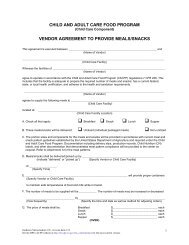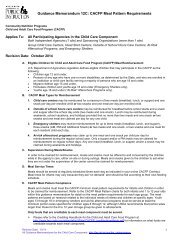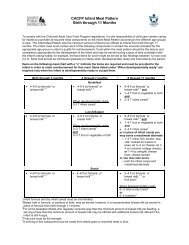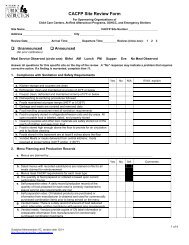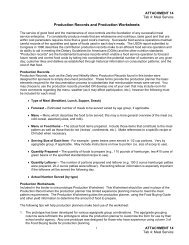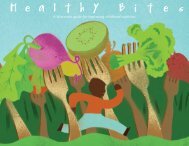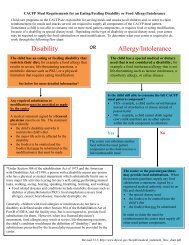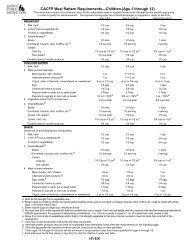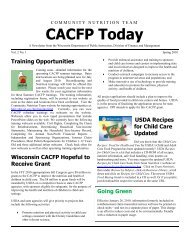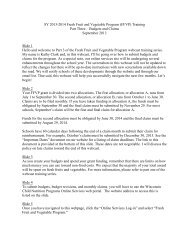not consume enough milk and dairy products. You can help by offering fat-freeand low-fat milk during the day to: Provide children with nutrients such as protein, calcium, vitamin D, andpotassium. Help build strong bones, teeth, and muscles in growing children. Increase the chance that children will drink milk when they are older.What type of milk should I offer children over 2 years old?Fat-free and low-fat (1%) milk options have the same amount of calcium and otherimportant nutrients as whole and reduced-fat (2%) milks, but much less fat.Starting at age 2, children should drink:‣ Fat-free or low-fat (1%) milk, or‣ Fat-free, or low-fat, lactose-free or lactose-reduced milk.How can I serve fat-free and low-fat milk?‣ Offer unflavored, fat-free and low-fat milks most often. These have lessadded sugar and fewer calories than flavored, whole, or reduced-fat milk.‣ Offer lactose-reduced or lactose-free milk to children who are lactoseintolerant.Making Water AvailableWhen children are thirsty between meals and snacks, water is the best beveragechoice. The amount of water needed will vary among children and increase on hotsummer days and during physical activity. You can help by making safe drinkingwater freely accessible to children throughout the day. Drinking water can: Keep children hydrated and healthy. Help build and maintain strong teeth, if water includes fluoride. Help rinse food from teeth and reduce acid in the mouth, both of whichcontribute to dental cavities.Help children develop a habit of drinking waterthat they will keep for life.Introducing NewFoodsPicky eating is common among young children. Some children are sensitive tocertain textures or smells and other children are afraid to try new foods. <strong>Child</strong>renare more likely to try and like new foods when you introduce new foods with funor interesting nutrition education activities and serve meals that look and tastegood Consider introducing new recipes gradually, and always have an alternatechoice available. Use these tips to help get kids excited about trying healthy newfoods and meals:Add a variety of colors, shapes, and textures to meals Use several different noodle shapes (macaroni, penne, etc.) to create a coldpasta salad or hot pasta dish. Add crushed pineapple, mandarin oranges, or fresh apples to salad mix orcoleslaw.32
Prepare a stir-fry with a variety of different colored vegetables. Use dark leafygreens, such as spinach, and add red peppers, shredded carrots, and redcabbage.Make food fun! Serve fresh vegetable sticks (zucchini, yellow squash, celery, red pepper) with“Snow Princess Dip” (low-fat ranch dressing), hummus (pureed chickpeas,olive oil, and lemon juice), or “Alligator Eyelash Dip” (plain, low-fat yogurtmixed with dill or other herbs). Try “Shark Pockets” (stuff half a whole-wheat pita pocket with canned lighttuna, spinach, shredded carrots, and a little salad dressing) or “Mighty MonsterMeatloaf” (made with whole-grain bread or cracker crumbs and lean groundmeat). Add kidney and pinto beans in chili and serve it in a baked sweet potato “chiliboat.” Let children mash beans in a plastic bag, and then make a “SmashedBean Burrito” with a whole-grain tortilla, spinach, and their favorite veggies. Create themed food dishes for special events, holidays, and celebrations. Create your own Milk Mustache event! Take pictures of children drinking lowfatmilk and post them on a bulletin board. Sing a song while working with ingredients during a cooking demonstration orwhile mixing recipe ingredients!Cook together <strong>Child</strong>ren learn about fruits and vegetables when they help prepare them.Young children can help rinse fruits and make “faces” out of pieces of fruits.Pick kitchen tasks that match children’s abilities: mash bananas, peel somefruits, or mix ingredients for a fruit salad. Have children make a potato bar by choosing their own toppings for half abaked potato. Arrange separate bowls and serving utensils for refried beans,black-eyed peas, chopped chicken tenders, shredded low-fat cheese, slicedcherry tomatoes, thinly chopped spinach, and grated carrots for children tobuild their own baked potato. See the “Edible Art” activity from Team <strong>Nutrition</strong>’s Community <strong>Nutrition</strong>Action Kit at: http://www.fns.usda.gov/tn/Resources/edibleart.pdfIntroduce beans by adding them to children’s favorite foods Add beans and peas to pastas, tacos, casseroles, stews, and side dishes. Make “Mexican Pizza” by topping whole-wheat pita bread with refried beans,tomato salsa, spinach, and low-fat cheese.Introduce whole grains gradually, in new or familiar recipes Try mixing whole-grain and non-whole-grain foods in your recipes and meals.Then, gradually increase the amount of whole grains each time you makethem.Use taste tests and games to help kids try new foods Highlight unique fruits or vegetables, such as purple carrots from the farmer’smarket, with a “show and tell” each week. Have a bean guessing game or taste-test: let children sample dishes that use drybeans or peas as the main ingredient, and have children “name that bean!”Some ideas include lentil soup, bean dip, three bean salad, or bean burgers.33
- Page 1 and 2: The Summer Food Service ProgramSumm
- Page 3 and 4: CONTENTSINTRODUCTION ..............
- Page 5 and 6: Using a Food Thermometer ..........
- Page 7: DietaryGuidelines forAmericansThe D
- Page 10 and 11: FOOD COMPONENTS AND FOOD ITEMSSUMME
- Page 12 and 13: Offer VersusServe (OVS)Offer versus
- Page 14: More on FoodComponentsThis section
- Page 17 and 18: For lunch and supper, 8 oz. or 1 cu
- Page 19 and 20: ProductFormulationSchool Foodservic
- Page 21 and 22: Summer Menu PlanningIn this section
- Page 23 and 24: CalculatingServing Sizesand CostsCh
- Page 25 and 26: Sample Cycle MenusThe following is
- Page 27 and 28: Making the Most of Summer MealsBuil
- Page 29 and 30: fruits are naturally sweet, it can
- Page 31 and 32: Protect children’s hearts, brains
- Page 33: What type of grains should I offer?
- Page 37 and 38: SampleRecipesThe following recipes
- Page 39 and 40: 2 ¼ tsp Salt-free chili-lime seaso
- Page 41 and 42: Education and EnrichmentIn this sec
- Page 43 and 44: The Physical EnvironmentIf you are
- Page 45 and 46: PromotingPhysicalActivityWhile phys
- Page 47 and 48: Spotlight on Summer Food Service Pr
- Page 49 and 50: amounts of foods that will meet the
- Page 51 and 52: PART II — NUTRITION SERVICESHire
- Page 53 and 54: Getting Organized: Food Purchasing
- Page 55 and 56: DevelopingFoodSpecificationsWhen pr
- Page 57 and 58: How to Use theFood BuyingGuideUSDA'
- Page 59 and 60: Additional information about calcul
- Page 61 and 62: MenuProductionRecordsThe SFSP regul
- Page 63 and 64: ScoopsThe number of the scoop indic
- Page 65 and 66: Keep Food Fresh: Food StorageIn thi
- Page 67 and 68: Drive Dirt and Germs Out: Food Sani
- Page 69 and 70: Take Precautions: Food SafetyIn thi
- Page 71 and 72: SEPARATESeparate foods that are rea
- Page 73 and 74: For additional information, visitht
- Page 75 and 76: Call the local or State Health Depa
- Page 77 and 78: E. Coli ReportAccording to USDA's F
- Page 79 and 80: Minimum Safe Internal Temperatures
- Page 81 and 82: Approximate Storage Life in Days of
- Page 83 and 84: e Will harden at high temperature,
- Page 85 and 86:
Frozen Food Storage (continued)The
- Page 87 and 88:
f Garlitz, Carol J., Boor, K., and
- Page 89 and 90:
Food Safety ChecklistDate__________
- Page 91 and 92:
Food Safety Checklist, continuedFOO
- Page 93 and 94:
Questions and Answers1. I have to h
- Page 95 and 96:
with food safety information, which
- Page 97 and 98:
MyPlateThe U.S. Department of Agric
- Page 99 and 100:
meal. Example: An orange and orange
- Page 101 and 102:
GROUP DMINIMUM SERVING SIZE FOR GRO
- Page 103 and 104:
How to Read Nutrition LabelsNutriti
- Page 105 and 106:
3. Limit these nutrientsIn general,
- Page 107 and 108:
Food Sources of Vitamin A (Continue
- Page 109 and 110:
Food Sources of Vitamin C (Continue
- Page 111 and 112:
Food Sources of Vitamin C (Continue
- Page 113 and 114:
Food Sources of Iron (Continued)Foo
- Page 115 and 116:
Food Sources of CalciumAll foods li
- Page 117 and 118:
Serving Sizes and Yields for Vegeta
- Page 119 and 120:
Serving Sizes and Yields for Fruits
- Page 121 and 122:
e of the Position:Sample Position D
- Page 123 and 124:
Food Service Equipment NeedsEquipme
- Page 125 and 126:
Quaternary ammonium compounds (Quat
- Page 127 and 128:
Sanitize Smallware in a Mechanical
- Page 129 and 130:
CAUTION:All equipment should be kep
- Page 131 and 132:
Food Inventory Record InstructionsT
- Page 133 and 134:
Date Marking Ready-to-Eat, Potentia
- Page 135 and 136:
DAILY TEMPERATURE FORM - INTERNAL F
- Page 137 and 138:
RESOURCE SECTIONInformation Resourc
- Page 139 and 140:
Nutrition.govNIFANCEMCHAdditional o
- Page 141 and 142:
Serving It Safe: A Manager’s Tool



